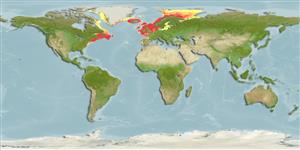>
Gadiformes (Cods) >
Gadidae (Cods and haddocks)
Etymology: Melanogrammus: Greek, melan, -anos = black + Greek, gramma = letter, signal (Ref. 45335).
More on author: Linnaeus.
Environment: milieu / climate zone / distribuzione batimetrica / distribution range
Ecologia
marino demersale; oceanodromo (Ref. 51243); distribuzione batimetrica 10 - 450 m, usually 10 - 200 m (Ref. 35388). Temperate; 79°N - 36°N, 76°W - 62°E
Northeast Atlantic: Bay of Biscay to Spitzbergen; in the Barents Sea to Novaya Zemlya; around Iceland; rare at the southern Greenland. Northwest Atlantic: Cape May, New Jersey to the Strait of Belle Isle.
Length at first maturity / Size / Peso / Age
Maturità: Lm 34.9 range ? - ? cm
Max length : 112 cm TL maschio/sesso non determinato; (Ref. 5951); common length : 35.0 cm TL maschio/sesso non determinato; (Ref. 4645); peso massimo pubblicato: 16.8 kg (Ref. 9988); Età massima riportata: 20 anni (Ref. 4645)
Spine dorsali (totale) : 0; Spine anali: 0. Mouth relatively small; lower jaw shorter than the upper jaw; chin barbel rather small. Lateral line dark, uninterrupted to about the end of the body. Lateral-line pores present on head. Scales overlapping. A large dark blotch is above the pectoral fin just below the lateral line.
Body shape (shape guide): fusiform / normal; Cross section: circular.
Adults are found more commonly from 80 to 200 m, over rock, sand, gravel or shells, usually at temperatures between 4° and 10°C. Feed mainly on small bottom-living organisms including crustaceans, mollusks, echinoderms, worms and fishes (sand lance, capelin, silver hake, American eels, herring and argentines) (Ref. 5951). A batch spawner (Ref. 51846). Undertakes extensive migrations in the Barents Sea and Iceland. Sold fresh, chilled as fillets, frozen, smoked and canned. Also utilized for fish meal and animal feeds. Can be steamed, fried, broiled, boiled, microwaved and baked (Ref. 9988).
Oviparous, sexes are separate (Ref. 205). Spawning occurs in typically marine waters between 50 and 150 m depth (Ref. 1371).
Cohen, D.M., T. Inada, T. Iwamoto and N. Scialabba, 1990. FAO species catalogue. Vol. 10. Gadiform fishes of the world (Order Gadiformes). An annotated and illustrated catalogue of cods, hakes, grenadiers and other gadiform fishes known to date. FAO Fish. Synop. 125(10). Rome: FAO. 442 p. (Ref. 1371)
IUCN Red List Status (Ref. 130435: Version 2025-1)
Threat to humans
Harmless
Human uses
Pesca: elevato interesse commerciale; Acquacoltura: sperimentale; Pesce da pesca sportiva: si
Strumenti
Special reports
Download XML
Fonti Internet
Estimates based on models
Preferred temperature (Fonte Biblio.
123201): 1.4 - 12.1, mean 8.4 °C (based on 1651 cells).
Phylogenetic diversity index (Fonte Biblio.
82804): PD
50 = 1.0000 [Uniqueness, from 0.5 = low to 2.0 = high].
Bayesian length-weight: a=0.00661 (0.00582 - 0.00750), b=3.08 (3.04 - 3.12), in cm total length, based on LWR estimates for this species (Ref.
93245).
Trophic level (Fonte Biblio.
69278): 4.0 ±0.1 se; based on diet studies.
Generation time: 5.0 (4.6 - 5.6) years. Estimated as median ln(3)/K based on 36
growth studies.
Resilienza (Fonte Biblio.
120179): Medio, tempo minimo di raddoppiamento della popolazione 1.4 - 4.4 anni (rm=0.54-1.2; K=0.12-0.30; tm=2-6.5; tmax=20; Fec=100,000).
Prior r = 0.50, 95% CL = 0.33 - 0.75, Based on 41 full stock assessments.
Fishing Vulnerability (Ref.
59153): Moderate to high vulnerability (55 of 100).
🛈
Climate Vulnerability (Ref.
125649): Moderate vulnerability (40 of 100).
🛈
Nutrients (Ref.
124155): Calcium = 10.2 [3.2, 40.2] mg/100g; Iron = 0.175 [0.075, 0.825] mg/100g; Protein = 18 [16, 20] %; Omega3 = 0.617 [0.316, 1.243] g/100g; Selenium = 32.9 [12.1, 89.8] μg/100g; VitaminA = 7.92 [2.06, 29.85] μg/100g; Zinc = 0.309 [0.168, 0.623] mg/100g (wet weight); based on
nutrient studies.
